1202.19 Repeating-Pattern Marks
A repeating-pattern mark is a mark composed of a single repeated element or a repeated combination of designs, numbers, letters, or other characters, forming a pattern that is displayed on the surface of goods, on product packaging, or on materials associated with the advertising or provision of services. The pattern may appear over the entire surface or on just a portion of the relevant item.![]()
Repeating-pattern marks are often applied to clothing and fashion accessories, but they also appear on other goods, including furniture, bedding, dinnerware, luggage, paper products, and cleaning implements. In addition, these marks frequently appear on packaging for a variety of goods and have been registered for use in connection with services such as retail stores and travel agencies. For examples of repeating-pattern marks, see TMEP §1202.19(k).![]()
In a repeating-pattern mark, the repetition of the mark’s elements is a feature of the mark, which must be appropriately specified in the application. See TMEP §§1202.19(a), (b). The fact that the specimen shows the mark depicted in the drawing being used in a repetitive fashion on the relevant items is not, by itself, a sufficient basis for treating the mark as a repeating-pattern mark. That is, despite what is shown in the specimen, the applicant might not be seeking a registration in which repetition is a feature of the mark. Accordingly, there also must be some indication in the mark description or on the drawing to indicate that the mark consists of a repeating pattern.![]()
If the nature of the mark is ambiguous, the examining attorney must seek clarification from the applicant through a Trademark Rule 2.61(b) requirement for information, or by telephone or email communication, as appropriate. See 37 C.F.R. §2.61(b); TMEP §814. Any clarification obtained through informal communication should be recorded in a Note to the File (also referred to as a Public Note or Notation to File) or in a subsequent Office action or examiner’s amendment. See TMEP §709.05. ![]()
A repeating pattern that is unique when used in connection with the relevant goods or services may be inherently distinctive. See TMEP §1202.19(e)(i)(A). However, because of the ornamental and typically nondistinctive nature of repeating patterns, consumers often do not perceive these patterns as source indicators, in which case they may not be registered on the Principal Register without proof of acquired distinctiveness. See TMEP §§1202.19(e)–(e)(iii).![]()
1202.19(a) Drawing Requirements for Repeating-Pattern Marks
The drawing for a repeating-pattern mark must be a substantially exact representation of the mark. See 37 C.F.R. §2.51; TMEP §§807.12–807.12(d). The impression created by a repeating pattern may change depending on a number of factors, including the nature of the pattern and the item it appears on, the particular placement of the pattern on the item, and the size and scale of the elements in the pattern as applied. Thus, in most cases, to accurately depict the mark, a drawing showing the particular manner of display and placement of the repeating pattern is necessary. A swatch-type drawing—one that does not show the particular placement of the mark but instead consists of a sample of the repeating pattern displayed within a square, rectangle, or other geometric shape—is acceptable only under certain circumstances. See TMEP §1202.19(a)(iii) for additional information on swatch-type drawings.![]()
1202.19(a)(i) Mark Used on a Single Item
The drawing for a repeating-pattern mark applied in a particular manner to a single item must depict the pattern as it appears on the item. Thus, if the pattern appears only on a portion of the item, the drawing must show the pattern’s placement on that portion. If the pattern appears over the entire surface of the item, the drawing must depict the pattern accordingly. The shape of the item must appear in broken lines to indicate that it is not claimed as part of the mark. 37 C.F.R. §2.52(b)(4); TMEP §807.08. If the drawing shows the item in solid lines, the USPTO will interpret the drawing as indicating that the proposed mark is a composite mark consisting of both the repeating pattern and the shape of the item to which it is applied. Cf. TMEP §1202.05(d)(i).![]()
If it is unclear what portions of the drawing are claimed as part of the mark, the examining attorney must seek clarification from the applicant through a Trademark Rule 2.61(b) requirement for information, or by telephone or email communication, as appropriate. See 37 C.F.R. 2.61(b); TMEP §§709.05, 814. Based on that clarification, the examining attorney must also require the appropriate amendments to the drawing and mark description.![]()
See TMEP §§1202.19(f)–(f)(ii) regarding the relevant examination procedures when an application identifies goods that are inconsistent with the depiction of the mark in the drawing.![]()
1202.19(a)(ii) Mark Used in a Similar Manner on Similar Items
If the repeating pattern will be applied to multiple goods, a drawing showing the pattern’s placement on one of the goods is appropriate if all of the identified goods are similar in form and function, and the mark will appear in a similar manner on all of the goods. Under these circumstances, a depiction of one of the goods may be considered a substantially exact representation of the mark as used on all of the goods. For example, if a repeating pattern is used in a similar manner on similarly shaped purses of various sizes, a drawing showing the repeating pattern on one version of the purses (shown in broken lines) would be acceptable. Another example is a repeating-pattern mark that is applied in the same manner to the handles of tableware forks, spoons, and knives. In that case, a drawing that depicts the mark on one of the items (shown in broken lines) would be acceptable.![]()
Likewise, if the repeating-pattern mark will appear in a similar manner on various sizes of similarly shaped product packaging, then a drawing showing the mark appearing on one version of the packaging depicted in broken lines is acceptable.![]()
1202.19(a)(iii) Mark Used in Various Ways or on Various Items ─ Swatch-Type Drawings
Sometimes an applicant uses, or intends to use, a repeating-pattern mark in various ways on the same or similar items, or in similar or different ways on a variety of items. In those circumstances, a drawing depicting the mark appearing on a particular item will not accurately depict the mark and the nature of its use.![]()
Previously, to address this issue, applicants have submitted swatch-type drawings, which do not show a particular placement of the mark, but instead consist of a sample of the repeating pattern within a square, rectangle, or other geometric shape. These swatch-type drawings usually will not adequately depict the nature of the mark for which registration is sought, because the impression created by a repeating pattern may change depending on the nature of the pattern, the type of item on which the pattern appears, the particular placement of the pattern on that item, and the size and scale of the elements in the pattern as applied. Accordingly, these swatch-type drawings could encompass multiple versions of the mark, each of which may convey a different commercial impression. Therefore, such swatch-type drawings are usually not appropriate for repeating-pattern marks, and examining attorneys generally should not accept them. ![]()
However, a swatch-type drawing is acceptable if the applicant shows with sufficient evidence that (1) the applied-for mark is actually used, or will be used, in various ways or on a variety of different items, but (2) it will nonetheless be perceived as a source indicator and create the same commercial impression across all uses. ![]()
The evidence of variable use need not show every use of the repeated pattern on the relevant items, but it should provide a reasonable basis for concluding that the use of the mark in connection with the identified goods or services is so varied that a single depiction of the mark on a particular item would not accurately reflect the nature of the mark. For applications not based on use in commerce, the evidence should indicate the applicant’s intention to use the mark in various ways or on a variety of different items. This may include declarations, marketing materials, and other similar matter.![]()
The evidence as to the commercial impression must be substantial and must establish that the pattern will be perceived as a source indicator and create the same commercial impression in the minds of consumers. Relevant evidence may include consumer declarations; advertisements or other materials showing various instances of the pattern being used together in one place (e.g., a single advertisement that shows the pattern being used in various ways on various goods, but nonetheless projecting the same commercial impression); sales figures relevant to the various items featuring the pattern; and any other evidence of the applicant’s efforts to promote the various uses of the repeating pattern as a single source indicator for the relevant goods or services, including "look-for"-type evidence. Although the evidence listed above is similar to evidence that would be submitted in support of an acquired-distinctiveness claim, here the examining attorney’s determination is focused not on whether the mark has acquired distinctiveness but on whether the use or intended use of the mark, and the likely consumer perception of it, satisfy the specified conditions for acceptance of a swatch-type drawing. ![]()
Even if these conditions are satisfied, an examining attorney must also consider the applied-for mark’s distinctiveness. For example, to support a swatch-type drawing for such varied goods as "business card cases; coin purses; cosmetic cases sold empty; dog collars; dog leashes; handbags; luggage tags; overnight bags; pet clothing; umbrellas; wallets; and wristlet bags" the applicant might submit some or all the following: a statement that the mark had been used for more than 10 years on hangtags, packaging, promotional materials, and across various product categories; evidence showing that it is a common practice in the industry for fashion brands to develop signature patterns; examples of pattern designs in the industry that have become well-recognized as source indicators; news articles and website excerpts touting the mark in connection with the applicant; examples of the mark in use on packaging, shopping bags, hangtags, and promotional materials; examples of various products featuring the mark; a declaration indicating substantial sales of products, packaging, or hangtags featuring the mark, as well as significant marketing expenditures relating to promotion of products featuring the repeating pattern. While this kind of evidence might be submitted to support a claim of acquired distinctiveness, it is also the kind of evidence that may support the submission of a swatch-type drawing, because it shows that the repeating-pattern mark is used in various ways on a variety of items and that the repeating pattern would be perceived as a source indicator and create in the minds of consumers the same commercial impression across that pattern’s various uses.![]()
If the applicant has submitted a swatch-type drawing but the evidence of record does not establish that a swatch-type drawing is appropriate, the examining attorney must refuse registration on the ground that the application seeks registration of more than one mark. See TMEP §§1202.19(g)–(g)(ii). ![]()
1202.19(a)(iv) Drawings for Service Marks
Repeating-pattern marks are used as service marks in a variety of ways. For instance, a repeating-pattern mark could be displayed on a retail store’s façade, on a customer loyalty card, on advertising materials, or on shopping bags.![]()
If a repeating pattern appears on elements in a service setting in a manner that makes a single commercial impression, such as a pattern that is displayed on the various architectural features or other fixtures of a retail outlet, a drawing of the setting should be submitted, along with a detailed description of the mark that specifies the location and manner of use of the repeating pattern. Cf. TMEP §1202.05(d)(ii) ("If color is used in a variety of ways, but in a setting that makes a single commercial impression, such as a retail outlet with various color features, a broken-line drawing of the setting must be submitted, with a detailed description of the mark claiming the color(s) and describing the location of the color(s).")![]()
The drawing must depict in broken lines those elements of the environment that display the repeating pattern but are not claimed as a feature of the mark. See 37 C.F.R. §2.52(b)(4); TMEP §807.08.![]()
Otherwise, if the mark is used on a particular item, or is used in a similar manner on multiple items that are similar in form and function, and can thus be adequately represented by a depiction of a single item, a drawing consisting of the mark appearing on a single item is appropriate. See TMEP §§1202.19(a)(i)–(ii).![]()
The conditions for accepting a swatch-type drawing for repeating-pattern marks used in connection with services are the same as those explained in TMEP §1202.19(a)(iii). ![]()
1202.19(b) Mark Descriptions for Repeating-Pattern Marks
The mark description must accurately describe the mark. See TMEP §808.02. Thus, the description for a repeating-pattern mark must indicate that the mark consists of a pattern. Although the description must identify the various elements of the pattern, it is not necessary to describe their exact placement within the pattern; it is sufficient for the description to generally characterize the elements and indicate that they are repeated. See id.![]()
In addition, the description must specify how the pattern will appear on the relevant items. Thus, if the pattern is applied only to a portion of the relevant goods, packaging, or other items, the description must specify that portion. If the pattern is repeated over the entire surface of the relevant items, the description must so indicate. And, if the pattern is displayed in various ways on the relevant items (see TMEP §1202.19(a)(iii)), then the mark description must include wording to that effect. For example, in the latter instance, the following description would be acceptable: "The mark consists of a repeating pattern of stars and circles used on various portions of the product packaging for the identified goods." ![]()
The mark description must also describe any portions of the mark that are shown in broken lines and thus are not claimed as a feature of the mark. See 37 C.F.R. §2.52(b)(4); TMEP §807.08. For repeating patterns featuring color, the application must include an appropriate color claim and the description must indicate where the claimed colors appear. 37 C.F.R. §2.52(b)(1).![]()
The mark description for a repeating-pattern mark must always be printed on the registration certificate. See TMEP §808.03.![]()
1202.19(c)(i) Amending the Drawing to Depict a Different Object
Generally, when the original drawing depicts the repeating pattern appearing on a particular object, amending the drawing to show the pattern appearing on a significantly different object will be considered a material alteration. Thus, if the original drawing shows the repeating pattern appearing on the outer surface of a purse, for example, it may not be amended to show the mark appearing on the handle of a walking cane.![]()
However, if the mark will appear in a similar manner on similar items, so that a depiction of only one of the items is a substantially exact representation of the mark as used on all of the items, the applicant may amend the drawing from a depiction of one of the items to a depiction of another of the items, assuming the shape of the items is not claimed as a feature of the mark and the specimen of use or foreign registration certificate supports the amendment. See 37 C.F.R. §2.72; TMEP §807.13. For instance, it would not be a material alteration to amend a drawing that shows the pattern appearing on the handle of a spoon shown in broken lines to show the pattern on the handle of a fork shown in broken lines. However, any item depicted in the drawing must be consistent with the identification of goods or services. See TMEP §1202.19(f).![]()
1202.19(c)(ii) Amending a Swatch-Type Drawing to Show an Object and Vice Versa
When the original drawing is a swatch-type drawing showing the elements of the pattern within a square, rectangle, or other generic geometric shape (see TMEP §1202.19(a)(iii)), the drawing may be amended to show the pattern appearing on a particular item, if necessary and otherwise appropriate. See TMEP §807.13. However, amending from a drawing showing the pattern on a particular object to a swatch-type drawing usually will be a material alteration, especially when the elements comprising the pattern are nondistinctive.![]()
1202.19(c)(iii) Amending the Drawing to Depict a Different Placement of the Repeating Pattern
When the original drawing shows the repeating pattern displayed in a particular manner on an object, amending the drawing to show the pattern being displayed in a significantly different manner on the same object may be a material alteration. For instance, a drawing that shows the repeating pattern on the outer bill of a baseball cap may not be amended to show the pattern on the inner lining of the cap. However, a minor change to the placement of a repeating pattern on an object should not be considered a material alteration. ![]()
1202.19(c)(iv) Amending Descriptions of Repeating-Pattern Marks
An applicant may not amend a mark description if the amendment would describe a materially different mark than what was depicted in the original drawing. See 37 C.F.R. §2.72; In re Thrifty Inc. 274 F.3d 1349, 1353, 61 USPQ2d 1121, 1124 (Fed. Cir. 2001) (finding applicant’s proposed amendment to the mark description was a material alteration of the drawing because the "multiple impressions created by the wide variety of objects sought to be covered under the proposed description differ significantly from the original mark of a color placed on a building").![]()
For applications in which the original drawing is a swatch-type drawing (see TMEP §1202.19(a)(iii)) and the original mark description indicates that the pattern is used a variety of ways, an applicant may amend the mark description to indicate that the pattern appears in a particular manner on a particular item, in accordance with a corresponding drawing amendment. These amendments are not considered material alterations. In these instances, the applicant may also be required to amend the identification of goods or services to delete any items that are inconsistent with the drawing. See TMEP §1202.19(f).![]()
1202.19(c)(v) Amendments in Applications Based on Section 44 or Section 66(a)
For applications based on Section 44 or Section 66(a), any amendments must conform to the rules and procedures governing these types of applications. See, e.g., TMEP §§1011.01 ("substantially exact representation standard" for drawings in §44-based applications), 1011.03 (amendment of drawings in §44-based applications), 1904.02(j) (amendment of marks in §66(a)-based applications), 1904.02(k) (drawings and descriptions in §66(a)-based applications). ![]()
1202.19(d) Specimens for Repeating-Pattern Marks
As with other types of marks, the specimen of use for a repeating-pattern mark must show use of the mark as depicted in the drawing and described in the mark description. See TMEP §§904, 904.07(a), 1301.04(g)(i).![]()
When a repeating pattern is applied to a single item, and the drawing thus depicts the repeating pattern on that item (see TMEP §1202.19(a)(i)), the specimen should show the pattern displayed on the same item or a substantially similar item. In addition, the placement of the pattern on the object in the specimen should be consistent with the placement as depicted in the drawing and specified in the description.![]()
When a repeating pattern is applied in the same manner to similar items and thus a drawing depicting one of the items is appropriate (see TMEP §1202.19(a)(ii)), the specimen of use need not show the item depicted in the drawing, assuming the shape of the item in the drawing is not claimed as a feature of the mark. However, the object shown in the specimen must be sufficiently similar to the item in the drawing, such that the drawing is a substantially exact representation of the mark as actually used. See TMEP §1202.19(a)(ii). In addition, if the mark is applied to goods, the good shown in the specimen must be encompassed by the identification of goods. Thus, if the identified goods are spoons, forks, and knives being tableware, and the drawing shows the repeating pattern appearing on the handle of a spoon shown in broken lines, a specimen showing the same pattern in the same manner on the handle of a fork would be acceptable. See TMEP §§1202.19(f)–(f)(ii) for a discussion of the relevant examination procedures when the identified goods or services are inconsistent with the drawing.![]()
When the drawing is a swatch-type drawing, and the examining attorney has determined that the drawing is appropriate (see TMEP §1202.19(a)(iii)), a specimen showing the pattern appearing on a particular object should be considered to match the drawing if the overall commercial impression created by the pattern is the same.![]()
The fact that the specimen shows the mark depicted in the drawing being used in a repetitive fashion on the relevant items is not, by itself, a sufficient basis for treating the applied-for mark as a repeating-pattern mark. There must be some indication in the mark description or drawing to indicate that the mark consists of a repeating pattern.![]()
If necessary, examining attorneys may require additional specimens to determine whether the applied-for mark functions as a trademark or service mark for all of the identified goods or services. See 37 C.F.R. §2.61(b); TMEP §904.01(a). For example, additional specimens may be necessary when the identified goods include items that are significantly different from the goods shown in the originally submitted specimen, such that it is not clear how the mark is used on all of the goods. ![]()
1202.19(e) Failure-to-Function Refusal – Mark Not Inherently Distinctive
The USPTO will not register an applied-for mark unless it functions as a mark. See 15 U.S.C. §§1051, 1052, 1053, 1127; In re Bose Corp., 192 USPQ 213, 215 (C.C.P.A. 1976) ("Before there can be registration, there must be a trademark . . . ."); In re Int’l Spike, Inc., 196 USPQ 447, 449 (TTAB 1977) ("Registration presupposes the existence of a trademark to be registered."); TMEP §1202. That is, the mark must serve as an indicator of the source of the goods or services, identifying and distinguishing them from those of others. See 15 U.S.C. §1127; TMEP §1202.![]()
The examining attorney must determine whether a repeating-pattern mark functions as a trademark or service mark by reviewing the available evidence, including the specimen and any other materials of record. See In re Safariland Hunting Corp., 24 USPQ2d 1380, 1381 (TTAB 1992) ("Since the specimens of record show how the applied-for mark is actually used in commerce, we must primarily look to the specimens to see if the designation would be perceived as a source indicator. However, we may also consider other evidence bearing on the question of what impact applicant's use is likely to have on purchasers and potential purchasers.").![]()
Not every designation that a party places on goods or packaging, or uses in connection with services, is an inherently distinctive source indicator, regardless of the party’s intentions when adopting the designation. In re Eagle Crest, Inc., 96 USPQ2d 1227, 1229 (TTAB 2010) ; In re Vertex Grp., LLC, 89 USPQ2d 1694, 1701 (TTAB 2009) ("As is the case with any trademark, mere intent that a word, name, symbol or device function as a trademark or service mark is not enough in and of itself."). Some designations are not capable of serving as a source indicator. See In re Eagle Crest, Inc., 96 USPQ2d at 1229; Am. Velcro, Inc. v. Charles Mayer Studios, Inc., 177 USPQ 149, 154 (TTAB 1973) . ![]()
1202.19(e)(i) Inherent Distinctiveness Determination
Because repeating patterns frequently serve an ornamental function in various contexts, they are often not inherently distinctive when applied to goods, packaging, or materials associated with services. Instead, consumers may perceive these patterns as nothing more than ornamentation or background matter serving no source-indicating function. Thus, determining whether a repeating-pattern mark is inherently distinctive and functions as a source indicator involves considering the impression created when the mark is used in connection with the identified goods or services. See In re Aerospace Optics, Inc., 78 USPQ2d 1861, 1862 (TTAB 2006) ("A critical element in determining whether matter sought to be registered is a trademark is the impression the matter makes on the relevant public. Thus . . . the critical inquiry is whether the asserted mark would be perceived as a source indicator. . . . To be a mark, the term must be used in a manner calculated to project to purchasers or potential purchasers a single source or origin for the goods. . . . We determine whether this has been achieved by examining the specimens of use along with any other relevant material submitted by applicant during prosecution of the application.").![]()
Relevant considerations when determining inherent distinctiveness include those discussed below.![]()
1202.19(e)(i)(A) Common or Widely Used Pattern
Evidence showing that the repeating pattern in the applied-for mark is similar to, or a mere refinement or variation of, a common pattern or a pattern that is widely used on the relevant items, may support the conclusion that the applied-for mark is not inherently distinctive. See Seabrook Foods, Inc. v. Bar-Well Foods, Ltd., 568 F.2d 1342, 1344, 196 USPQ 289, 291 (C.C.P.A. 1977) .![]()
On the other hand, if the nature of the repeating pattern is unique or unusual as applied to the relevant items, a finding of inherent distinctiveness may be appropriate. See Seabrook Foods, Inc., 568 F.2d at 1344, 196 USPQ at 291.![]()
However, the mere fact that the applicant is the only user of the particular repeating pattern is not dispositive as to the inherent distinctiveness of a mark featuring that pattern. See In re E S Robbins Corp., 30 USPQ2d 1540, 1543 (TTAB 1992) ("If the concept of inherent distinctiveness was defined as meaning simply ‘one and only,’ then one could obtain a registration for a design which, while ‘unique’ in this sense, differed only slightly from the designs of other competing products and/or containers."). The examining attorney must weigh this factor together with any other relevant factors. ![]()
1202.19(e)(i)(B) Pattern Creates a Distinct Commercial Impression Apart from Other Matter
The examining attorney should consider whether the pattern creates a commercial impression distinct from any wording or other matter that may also appear on the relevant items. See Seabrook Foods, Inc. v. Bar-Well Foods, Ltd., 568 F.2d 1342, 1344, 196 USPQ 289, 291 (C.C.P.A. 1977). If so, this weighs in favor of finding the pattern inherently distinctive. ![]()
1202.19(e)(i)(C) Nature of Elements in the Repeating Pattern
If a repeating-pattern mark contains an element, such as arbitrary wording, which would be perceived as a source indicator if it were to appear by itself, then the relevant consumers may be more likely to perceive the repeating pattern as a source indicator. ![]()
1202.19(e)(i)(D) Industry Practice
Purchasers are unlikely to view a repeating-pattern mark as an indicator of source if the relevant industry practice is to use repeating patterns in an ornamental fashion with the relevant goods or services. However, if, because of common industry practice, consumers have come to view repeating patterns on the surface of the relevant goods, packaging, or other materials as an indicator of source, and the applied-for mark is more than common background matter, then a finding that the mark is inherently distinctive may be appropriate. ![]()
1202.19(e)(i)(E) Type of Product
The type of item the mark is applied to affects whether consumers perceive the repeating pattern as a mark rather than merely as ornamental or other nondistinctive matter. For example, when repeating patterns appear on items such as clothing, curtains, pillows, bedding, carpet, furniture, and stationery, the patterns are likely to be perceived as decoration because those types of goods are typically purchased or used, at least in part, for their aesthetic appeal. On the other hand, if the type of item the mark is applied to does not usually feature decorative matter, or is not usually purchased or used for its decorative features, like power tools, industrial machinery, or surgical equipment, a repeating pattern may be more likely to be perceived as a source indicator. ![]()
1202.19(e)(ii) Statutory Basis for Refusal
When the applicant has sought registration of a repeating-pattern mark on the Principal Register without claiming acquired distinctiveness, and the examining attorney determines that the mark is not inherently distinctive, registration must be refused on the ground that the mark fails to function as a source indicator, citing Trademark Act §§1, 2, and 45 for trademarks, and §§1, 2, 3, and 45 for service marks. See 15 U.S.C. §§1051, 1052, 1053, 1127. The examining attorney must explain the specific reasons for the refusal and provide relevant supporting evidence. See TMEP §1202. The stated reason for refusal will usually be that the applied-for mark is merely ornamental as used on or in connection with the goods or services. However, in some instances, the applied-for repeating-pattern mark may be simply nondistinctive, serving neither an ornamental nor a source-indicating purpose. In either case, the same statutory bases apply.![]()
If registration is sought on the Supplemental Register, but the examining attorney determines that the mark is incapable of serving as a source indicator, registration must be refused on that ground under Trademark Act §§23 and 45. 15 U.S.C. §§1091, 1127.![]()
1202.19(e)(iii) Response Options
If an applied-for mark is capable of serving as a source indicator, the applicant may respond to the refusal by submitting a substitute specimen showing use of the mark as a trademark or service mark, amending to the Supplemental Register, or claiming acquired distinctiveness under Trademark Act Section 2(f), if otherwise appropriate. For repeating-pattern marks that are capable of serving as source indicators but are not inherently distinctive, evidence of five years’ use, by itself, is insufficient to show acquired distinctiveness. See TMEP §1212.05(a). That is, actual evidence showing that consumers have come to recognize the applied-for mark as a source indicator will be required to establish acquired distinctiveness. See id.![]()
Furthermore, for repeating-pattern marks used on goods, any showing of acquired distinctiveness must be made with respect to all of the identified goods for which the examining attorney has determined the mark is not inherently distinctive. For repeating-pattern marks used in connection with services, the evidence of acquired distinctiveness must establish that the mark, as used on all of the relevant items, has come to be perceived as a source indicator for the identified services.![]()
See TMEP §816 regarding amendment to the Supplemental Register and TMEP §§1212-1212.10 regarding claims of acquired distinctiveness.![]()
The applicant may also submit evidence of secondary source to establish that a repeating-pattern mark primarily serves a source-indicating function rather than merely serving as ornamentation. As discussed in TMEP §1202.03(c), there are a number of acceptable types of evidence for showing secondary source, such as proof of ownership of a use-based U.S. registration on the Principal Register for the same mark covering other goods or services. However, evidence of a series of ornamental uses of a repeating-pattern mark on various items will not establish that the proposed mark functions as an indicator of secondary source; use as a trademark or service mark for the other goods or services must be shown. TMEP §1202.03(c); see also In re Astro-Gods Inc., 223 USPQ 621, 622-24 (TTAB 1984) . ![]()
1202.19(f) Failure-to-Function Refusal – Inconsistent Goods or Services
When the drawing shows the repeating pattern appearing on an item, the examining attorney must determine whether all of the identified goods or services are consistent with the item depicted, such that the mark shown accurately reflects how the mark appears on all of the identified goods and services and could actually serve as a source indicator for them.![]()
For example, in an application that depicts the mark as a repeating pattern appearing on the bill of a baseball cap shown in broken lines, the cap is not part of the mark, but the drawing nonetheless limits the mark to the particular manner of use shown. Thus, if the application identifies the goods as baseball caps, shoes, eyeglasses, and purses, the identified baseball caps are consistent with the drawing, but the identified shoes, eyeglasses, and purses are not, because the mark obviously cannot be applied to those goods in the manner depicted in the drawing. If, on the other hand, the drawing depicts a repeating pattern applied to the handle of a hand rake, any other similar type of implement with a handle that is listed in the identification of goods should be considered to be consistent with the drawing. ![]()
If the drawing shows the repeating-pattern mark appearing on packaging for goods, the identified goods should be considered consistent with the drawing if they could be sold in the packaging shown. For instance, if the packaging shown is a bottle, then goods that are not normally packaged in a bottle should be considered inconsistent with the nature of the mark as depicted in the drawing, assuming there is no evidence that the applicant’s goods actually are packaged in that manner. ![]()
The fact that an application identifies services, but contains a drawing showing the mark applied to a particular object, does not necessarily raise an issue of inconsistency. Marks of this nature may function as source indicators for services. For example, a repeating pattern applied in a particular manner to the exterior of an airplane could be perceived as a source indicator for airline transportation services. However, if the application identifies both goods and services, the examining attorney must consider whether the mark shown in the drawing could actually function as both a trademark for the identified goods and a service mark for the identified services.![]()
The determination of whether all of the identified goods or services are consistent with the drawing is distinct from the determination of whether the drawing agrees with the specimen of record. See TMEP §1202.19(d). Thus, if the application contains specimens showing that the drawing is not a substantially exact representation of the mark as used on the goods or packaging, or in connection with the services, the examining attorney must also issue any applicable requirement or refusal on that basis. See TMEP §807.12(a).![]()
1202.19(f)(i) Statutory Basis for Refusal
If the examining attorney determines that any of the identified goods or services are inconsistent with the drawing, the examining attorney must refuse registration as to those goods or services on the ground that the mark, as depicted in the drawing, fails to function as a mark for them. Cf. TMEP §§1202.02(f)(i), 1202.02(f)(ii). The statutory bases for the refusal are Trademark Act §§1, 2, and 45 for trademarks, and §§1, 2, 3, and 45 for service marks. See 15 U.S.C. §§1051, 1052, 1053, 1127.![]()
1202.19(f)(ii) Response Options
The applicant may overcome the refusal by deleting the inconsistent goods or services, or by submitting evidence that the mark, as depicted in the drawing, does in fact function as a mark for the relevant goods or services. In most instances, the applicant will be unable to overcome the refusal by amending the drawing to cover all of the identified goods or services because it will be impossible to do so using a single depiction of the mark and the necessary changes are likely to result in a material alteration of the mark on the original drawing. See TMEP §1202.19(c). In addition, dividing out the inconsistent goods or services typically is not an appropriate response option in these cases because the drawing in the child application would need to depict an essentially different mark, which would also be a material alteration of the mark in the original drawing.![]()
1202.19(g) Refusal – Application Seeks Registration of More than One Mark
As explained in TMEP §1202.19(a)(iii), a swatch-type drawing is acceptable only if the applicant has submitted sufficient evidence to establish that the mark is applied to various items but that these various uses of the repeating pattern nonetheless create the same commercial impression.![]()
1202.19(g)(i) Statutory Basis for Refusal
In the absence of the evidentiary showing discussed in TMEP §1202.19(a)(iii), a swatch-type drawing is deemed to encompass numerous versions of the mark, each of which may create a different commercial impression, and thus the examining attorney must refuse registration under Trademark Act Sections 1 and 45, 15 U.S.C. §§1051, 1127, on the ground that the application seeks registration of more than one mark. See In re Int'l Flavors & Fragrances Inc., 183 F.3d 1361, 1366, 51 USPQ2d 1513, 1516 (Fed. Cir. 1999) ("[U]nder the Lanham Act and the rules promulgated thereunder, a trademark application may only seek to register a single mark."); TMEP §1214.01; cf. In re Hayes, 62 USPQ2d 1443, 1445 (TTAB 2002) (noting that a trademark application may only seek to register a single mark and affirming refusal of registration on the basis that applicant’s mark description described more than one mark); In re The Upper Deck Co., 59 USPQ2d 1688, 1689-91 (TTAB 2001) (affirming refusal to register a mark described as "a hologram device which is applied to . . . trading cards" because the mark could encompass many different holograms having various shapes, sizes, and contents, and thus the application sought to register more than a single mark); In re Elvis Presley Enters., 50 USPQ2d 1632, 1633-34 (TTAB 1999) (affirming refusal to register a mark described as "the likeness and image of Elvis Presley" because the drawing failed to convey a substantially exact representation of the mark and, given that the mark could encompass numerous likenesses of Elvis, the application sought to register more than a single mark). ![]()
1202.19(g)(ii) Response Options
In response to this refusal, the applicant may amend the swatch-type drawing to depict the mark on a particular item; amend the mark description to describe the placement of the mark on that item; and, if necessary, amend the identification to delete any goods or services that are inconsistent with the drawing (see TMEP §1202.19(f)). ![]()
1202.19(h) Refusals in Applications Based on Section 1(b), Section 44, or Section 66(a)
The refusals discussed in TMEP §§1202.19(e)–(g)(ii) may also apply to applications based on Trademark Act §1(b), §44, or §66(a) if the information in the application or any other available evidence indicates that the applied-for mark fails to function as a trademark or service mark; that the identification includes goods or services that are inconsistent with the mark as depicted in the drawing; or that the application seeks registration of more than one mark. See TMEP §1202; cf. In re Right-On Co., 87 USPQ2d 1152, 1157 (TTAB 2008) (noting that, with respect to §66(a) applications, "it is appropriate for examining attorneys to issue an ornamentation refusal if the mark is decorative or ornamental on its face as depicted on the drawing page and described in the description of the mark"); TMEP §1202.02(f)(i).![]()
For §1(b) applications, if the examining attorney anticipates issuing a failure-to-function refusal once an allegation of use is filed, the examining attorney should advise the applicant of the potential refusal if otherwise issuing an Office action. See TMEP §1202. However, failure to provide an advisory does not preclude the examining attorney from subsequently issuing a refusal. See id.![]()
With respect to applications based on §44 or §66(a), examining attorneys must adhere to the relevant rules and procedures governing these types of applications, including those pertaining to drawing amendments and acceptable response options. See, e.g., TMEP §§801.02(b) (Supplemental Register not an option for §66(a) requests for extension of protection), 1010 (proof of acquired distinctiveness in §44-based applications), 1011.01 ("substantially exact representation standard" for drawings in §44-based applications), 1011.03 (amendment of drawings in §44-based applications), 1904.02(g) (time period for issuing a refusal of a §66(a)-based application), 1904.02(j) (amendment of marks in §66(a)-based applications), 1904.02(k) (drawings and descriptions in §66(a)-based applications).![]()
1202.19(i) Functional Repeating Patterns
It is possible, although rare, that a repeating pattern applied to the surface of an item will serve a functional purpose. This could be a utilitarian function, which is essential to the use of the item or affects the cost or quality of the item, or an aesthetic function, which does not have a truly utilitarian function in terms of the item’s use or performance, but nonetheless provides a real and significant competitive advantage. See TMEP §§1202.02(a)(iii)(A), 1202.02(a)(vi). For example, a repeating pattern could function as camouflage for a product that requires concealment (utilitarian functionality). Or a repeating pattern could make a product more aesthetically desirable, beyond mere ornamentation, by allowing the product to be visually coordinated with a variety of other related items (aesthetic functionality). See Brunswick Corp. v. British Seagull Ltd., 35 F.3d 1527, 1531-1533, 32 USPQ2d 1120, 1122-1124 (Fed. Cir. 1994) (affirming TTAB’s determination that the color black on the surface of outboard motors is functional because, while it has no utilitarian effect on the mechanical purpose of the engines, it does provide other identifiable competitive advantages, including compatibility with a wide variety of boat colors and reduction in the perceived size of the engines). If the available evidence supports the conclusion that a repeating-pattern mark is functional, the examining attorney must refuse registration accordingly. See TMEP §§1202.02(a)–(a)(viii) regarding functionality and the procedures for refusing registration.![]()
1202.19(j) Random Patterns
The foregoing guidance on repeating patterns also generally applies to marks consisting of random or fractal patterns, that is, patterns in which the relevant elements are not repeated in a set or easily recognized way. However, examining attorneys must carefully review the drawing, mark description, and specimen of use for this type of mark to ensure not only that the application accurately depicts and describes the mark, but also that the mark creates the impression of a single mark.![]()
1202.19(k) Examples of Repeating-Pattern Marks 
Registered Repeating-Pattern Marks ![]()
U.S. Registration No. 3826587 (Supplemental Register)![]()
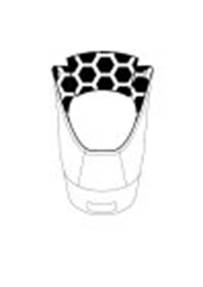
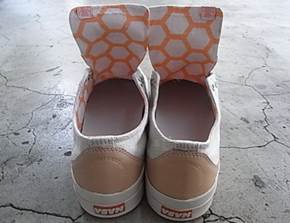
Mark Description: "The mark consists of a repeating pattern of hexagonal shapes printed or stitched on the inner lining of shoe uppers. The matter shown in broken or dotted lines is not part of the mark and serves only to show the position or placement of the mark on the goods."![]()
Goods: Shoes, in International Class 25. ![]()
Note: Although the shape of the shoe in the drawing differs slightly from the shape of the shoe in the specimen, the drawing is a substantially exact representation of the mark as used on the goods.![]()
U.S. Registration No. 3679828 (Principal Register – §2(f))![]()
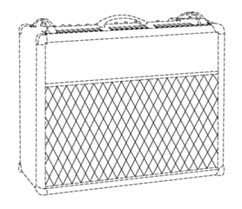
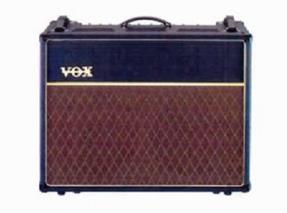
Mark Description: "The mark consists of a repetitive diamond pattern on the cloth speaker grill of a musical instrument amplifier. The dotted lines shown on the drawing are for purposes of positioning only and do not comprise a feature of the mark."![]()
Goods: Musical instrument amplifiers, in International Class 9. ![]()
Note: The application for this mark included a large amount of evidence to establish that the mark had acquired distinctiveness as a source indicator, including samples of marketing materials, excerpts from publications, and numerous consumer declarations. ![]()
U.S. Registration No. 3342382 (Principal Register - Cancelled)![]()
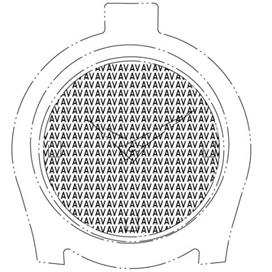
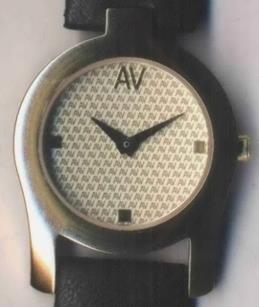
Mark Description: "The mark consists of a repeating pattern of ‘AV’ on the face of a watch."![]()
Goods: Watches, in International Class 14. ![]()
Note: The drawing shows the outline of the watch in broken lines, but the mark description does not specify the meaning of the broken lines. As indicated in TMEP §§807.08 and 1202.19(b), descriptions of marks containing broken lines must indicate the significance of the lines.![]()
U.S. Registration No. 4100365 (Supplemental Register)![]()
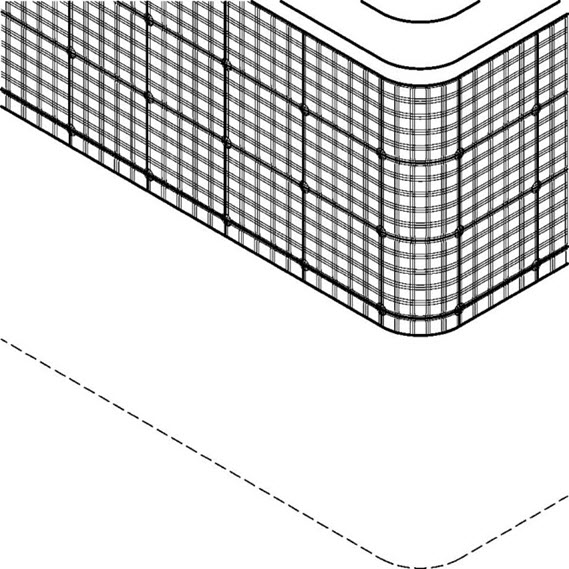
Mark Description: "The mark consists of a plaid design located on and covering the entire perimeter of the side border of a mattress, the plaid design comprising a repeat pattern no larger than approximately 1 to 1.6 inches in both its horizontal and vertical dimensions. The matter shown in dotted lines is not part of the mark but merely serves to show the placement of the mark on the goods."![]()
Goods: Mattresses, in International Class 20. ![]()
Note: Although the entire shape in the drawing here is not depicted in broken lines, as indicated in TMEP §§807.08 and 1202.19(a)(i), broken lines must be used to indicate the shape of an item depicted in a drawing if the shape is not claimed as part of the mark.![]()
U.S. Registration No. 1251171 (Principal Register)![]()
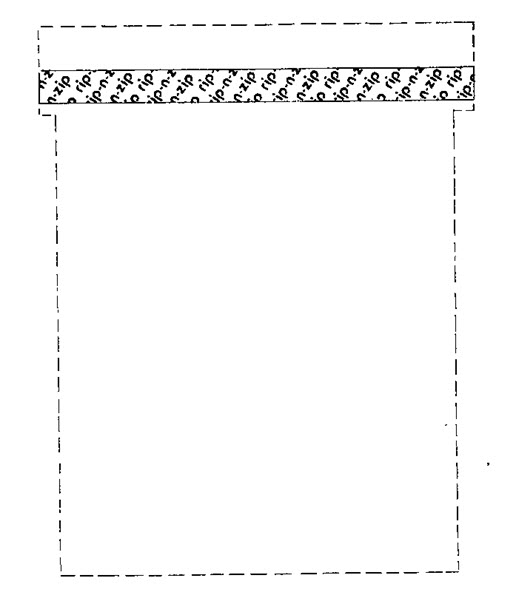
Mark Description: "The mark consists of a design showing the words ‘Rip-N-Zip’ repeated in a diagonal pattern along a strip extending across the upper portion of the multiwall bags."![]()
Goods: Reclosable Multiwall Bags, in International Class 22. ![]()
Note: The drawing shows the outline of the goods in broken lines, but the mark description does not specify the meaning of the broken lines. As indicated in TMEP §§807.08 and 1202.19(a)(i), marks containing broken lines must indicate the significance of the lines (e.g., that they indicate matter that is not part of the mark).![]()
U.S. Registration No. 2963354 (Principal Register)![]()
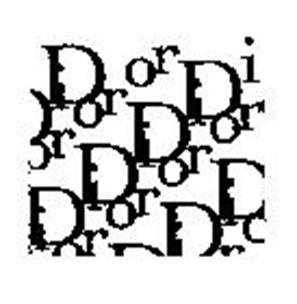
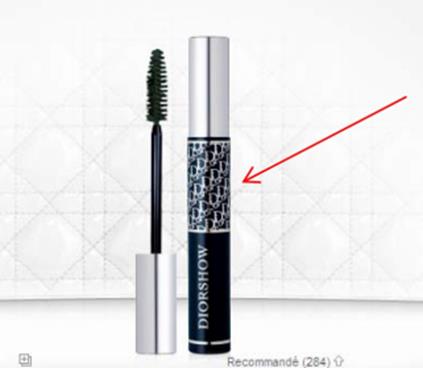
Goods: Perfumery; cosmetics, in International Class 3. ![]()
Note: Here, the repeating pattern is not a common, widely used pattern, but is instead composed of a stylized depiction of the wording DIOR. Furthermore, the pattern is placed only on part of the goods, in a place where a trademark might appear. Although a repeated pattern often produces an ornamental effect, the repeated element here is distinctive and could serve as a source indicator if presented in a single instance, rather than being repeated. Accordingly, the mark is, as used on the goods, inherently distinctive. See TMEP §§1202.19(e)(i)–(e)(i)(E).![]()
Although this registration does not include a mark description, under TMEP §§808.02 and 1202.19(b), a mark description for a repeating-pattern mark must accurately describe the elements that appear in the mark and indicate that they are repeated. In addition, to use a swatch-type drawing like the one shown here, the applicant must satisfy the requirements described in TMEP §1202.19(a)(iii). Otherwise, a drawing showing placement on the relevant item is required. See TMEP §1202.19(g)(ii). ![]()
Making Inherent Distinctiveness and Inconsistent Goods/Services Determinations ![]()
The following mock example is provided to illustrate concepts involved in determining whether a mark is inherently distinctive and whether the identified goods or services are consistent with the drawing. See TMEP §§1202.19(e)(i)–(e)(i)(E) and 1202.19(f) for additional information.![]()
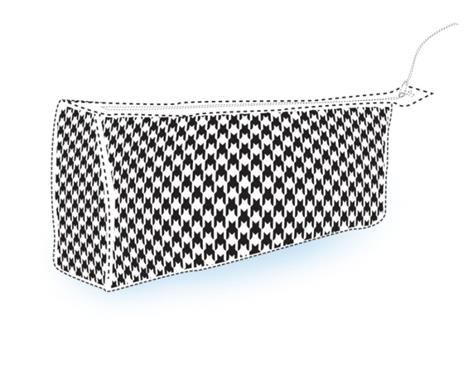
Mark Description: The mark consists of a repeated houndstooth pattern applied to the entire exterior surface of the side and end panels of a handbag. The matter shown in broken lines is not part of the mark and serves only to show the placement of the mark on the goods.![]()
Goods: Handbags; purses; walking canes, in International Class 18.![]()
Note: Although source-indicating matter is often displayed in a repetitive manner on the surface of handbags and purses, here the mark consists of a common pattern, houndstooth, which is widely used on clothing, fashion accessories, household items, and many other goods. There is nothing unusual or distinctive about the manner in which this common pattern is displayed or placed, and thus the pattern will likely be perceived as purely ornamental. Therefore, the mark is not inherently distinctive and does not function as a source indicator for the goods. See TMEP §§1202.19(e)(i)–(e)(i)(E).![]()
In addition, some of the identified goods are inconsistent with the drawing. While the handbag shown in the drawing is not part of the mark, the drawing nonetheless limits the mark to the particular manner of use shown. The mark could be applied in the manner shown to handbags and purses, but not to walking canes. Therefore, it is appropriate to refuse registration of the mark as to "walking canes" on the ground that the mark, as depicted in the drawing, fails to function as a mark for those goods. See TMEP §§1202.19(f)–(f)(ii).![]()
While the pattern shown in this mock example is not distinctive as depicted in the drawing, it is possible for a commonly used pattern to be inherently distinctive, or to otherwise acquire distinctiveness, if it is used in an unusual manner on the goods, such as when the pattern appears in a unique way on a particular portion of the goods.![]()